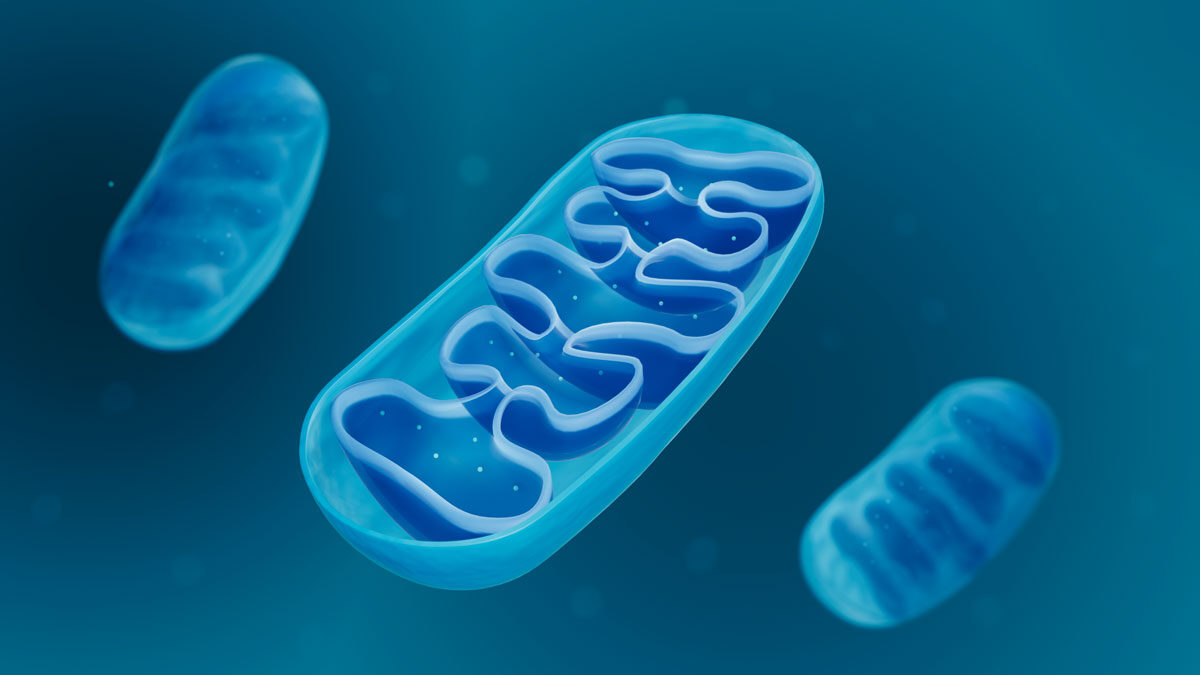


The impact of mitochondria on health has received increasing attention in recent years. Mitochondria affect the quality of life and the rate of aging; hence, protecting mitochondria can prevent aging and chronic diseases, and even fight cancer.
According to a paper in the journal Molecular Basis of Disease, metabolic abnormalities are prevalent in many chronic diseases such as cardiovascular diseases, obesity, diabetes, and even cancer, and mitochondria play a central role in energy metabolism.
Mitochondria are small organelles in the cells. They are very small, typically between 0.75 and 3 microns, and cannot be seen under a microscope unless it is stained.
The number of mitochondria in each cell varies, ranging from a few hundred to a few thousand. Cells with high energy demands, such as liver cells and cardiac muscle cells, tend to have more mitochondria.
Mitochondria, aptly called a “cell’s power plant” and “energy factory,” is the main site of ATP (energy currency of the cell) production. Mitochondria use oxygen to further process glucose and fatty acids from food, thereby generating ATP that powers metabolic processes. Mitochondria in cells produce 90 percent of the energy our bodies need to function, according to the Molecular Basis of Disease paper. The average cell uses 10 billion ATP per day, while a typical adult requires 3.0×1025 ATP per day.
Mitochondria must function stably because our bodies cannot store ATP. At any given moment, a person has about 250 grams of ATP in their cells, which equates to 4.25 watts, or the energy stored in a single AA battery, and a healthy person will generate up to 1200 watts of energy per day.
Mitochondria also control apoptosis in cells.
Cells have life cycles; as they decline in function and become senescent, they enter a phase of destruction and clearance, also known as apoptosis.
Mitochondria determine which cells need to undergo apoptosis, in which case, they release a substance that activates the enzymes responsible for apoptosis, causing the cell to enter the apoptotic process.
Cancer cells can multiply and grow indefinitely because the apoptosis mechanism has failed. Apoptosis requires ATP; if the energy supply does not meet the cell’s needs, it cannot carry out the process.
Mitochondria also maintain the stability of calcium in the body and generate heat.
Mitochondria are fragile. Mitochondrial function can be affected by factors such as viral infection, inflammation, certain nutrient deficiencies, chemical toxins, heavy metals, radiation, etc.
Mitochondria are also susceptible to oxidative damage from within—that is, damage caused by free radicals (also known as reactive oxygen species), a byproduct of mitochondrial metabolic processes. For example, mitochondria produce more energy when we eat, and more free radicals are generated as a result.
All of these factors will damage mitochondria or interfere with their ability to repair. When the mitochondria sense these threats, they will shut down the energy factories and alert the nucleus of the danger. At this point, mitochondrial function shifts from energy production to cellular defense.
Dr. Michael Chang, founder and attending physician of the Healed and Whole Clinic in California and the author of the book Mitochondrial Dysfunction: a Functional Medicine Approach to Diagnosis and Treatment, emphasized in an interview with The Epoch Times that the two functions of mitochondria are mutually exclusive, and they can only perform one of the two functions—once the energy-generating mechanism in the mitochondria changes or malfunctions, we are in trouble.
Cells with malfunctioning mitochondria will become starved of energy. The symptoms that people experience can vary greatly depending on the cell type.
These symptoms range from mild fatigue, sleep disturbances, decreased stamina, mood swings, and muscle and joint pain, to severe fatigue, brain fog, anxiety, depression, and heart and respiratory problems. Age-related degenerative conditions, such as hearing and vision loss and skin wrinkles, are also linked to mitochondria. Some other common diseases involving mitochondrial dysfunction include diabetes, cardiovascular disease, neurodegenerative disease, aging, chronic fatigue syndrome, fibromyalgia, infertility, and even cancer.
According to Chang’s estimation, about 50 percent of his patients have mitochondrial dysfunction, and the symptoms of these patients are diverse. The first symptom may be fatigue, while other symptoms include hormonal imbalance, which occurs because cells lack the energy to function properly. Many people also develop brain fog, because the brain is a high-energy-consuming organ. Some people may also show symptoms of cardiac dysfunction, such as heart failure.
This is the first thing to keep an eye on if you want to keep your mitochondria healthy. Avoid:
It should be noted that stress and negative emotions can also affect the health of mitochondria, and they should be dealt with promptly.
Coenzyme Q10 is a key cofactor required for the functioning of mitochondria and an important component of cellular respiration. It is also a powerful antioxidant that affects cell signaling, metabolism, and energy transport. Many clinical trials have proven that coenzyme Q10 promotes energy production and reduces fatigue.
In a Spanish study, patients with fibromyalgia were randomly divided into two groups, one of which took 300 mg of coenzyme Q10 per day for 40 days. Compared with the placebo group, the coenzyme Q10 group experienced an approximately 52 percent reduction in fibromyalgia symptoms, with the most significant reduction in pain at 52 percent, fatigue at 47 percent, and morning tiredness at 44 percent.
A meta-analysis published in August 2022 showed that coenzyme Q10 can significantly reduce fatigue. Moreover, the group that took only coenzyme Q10 demonstrated a significant fatigue-alleviating effect compared to those who also took other nutritional supplements.
Aging-related diseases and many chronic diseases, including cancer, are linked in some way to mitochondrial dysfunction.
Thomas N. Seyfried, a well-known scholar in cancer research and a professor of biology at Boston College, said in an interview with The Epoch Times that cancer is not a genetic disease, but a metabolic disease; and cancer is the result of cellular metabolism disorder. The mitochondrial metabolism of cancer cells is different from the efficient aerobic respiration used by normal cells. It does not use oxygen and produces much less ATP, while cancer cells can only obtain energy by decomposing glucose and glutamine.
Chang mentioned in his book that diabetes can be reclassified as a metabolic disorder rather than an endocrine disease. This is because the root of the problem is not insulin resistance, but mitochondrial dysfunction. When mitochondria fail to function properly, the rate of fat oxidation and energy production will drop, resulting in fat accumulation in our muscles and liver. These fats are converted to lipid peroxides that are cytotoxic, which further damage the mitochondria. Decreased mitochondrial function in beta cells also slows insulin secretion, leading to impaired glucose tolerance, hyperglycemia, and eventually Type 2 diabetes.
The ketogenic diet switches the mitochondria from burning glucose to burning ketone bodies, which produces relatively less toxic substances in the form of free radicals. Ketone bodies are a relatively cleaner fuel for mitochondria. Furthermore, cancer cells cannot metabolize ketone bodies. Therefore, the purpose of the ketogenic diet is to cut off the rations of cancer cells so that cancer can be reversed.
Intermittent fasting is good for the mitochondria. This is because, if we are constantly eating, the mitochondria have to keep burning fuel. Chang described it as like leaving the car engine running all the time and producing a lot of exhaust even though you are not traveling. Mitochondria build up damaging free radicals when they are constantly working. Intermittent fasting also keeps blood from rushing to the digestive tract to aid digestion; the gut can rest and its cells have a chance to repair themselves.
In addition, intermittent fasting can stimulate cells and mitochondria to start autophagy—like performing a spring cleaning—and form new mitochondria.
In addition to choosing unprocessed, natural, and organic foods, Chang suggested that we should relax and eat slowly with gratitude at mealtimes, as it can reduce internal stress, protect mitochondria, and help digestion.
Chang said that compared with low- and medium-intensity exercise, high-intensity interval training is relatively more beneficial to mitochondria. Besides, short bursts of high- and low-temperature stimulation, such as in saunas and cold baths, can stimulate mitochondria and boost their function.
Exercises like a long jog on a treadmill are not necessarily ideal. Chang explained that this may elevate stress hormones and also exhaust the mitochondria due to prolonged work.


